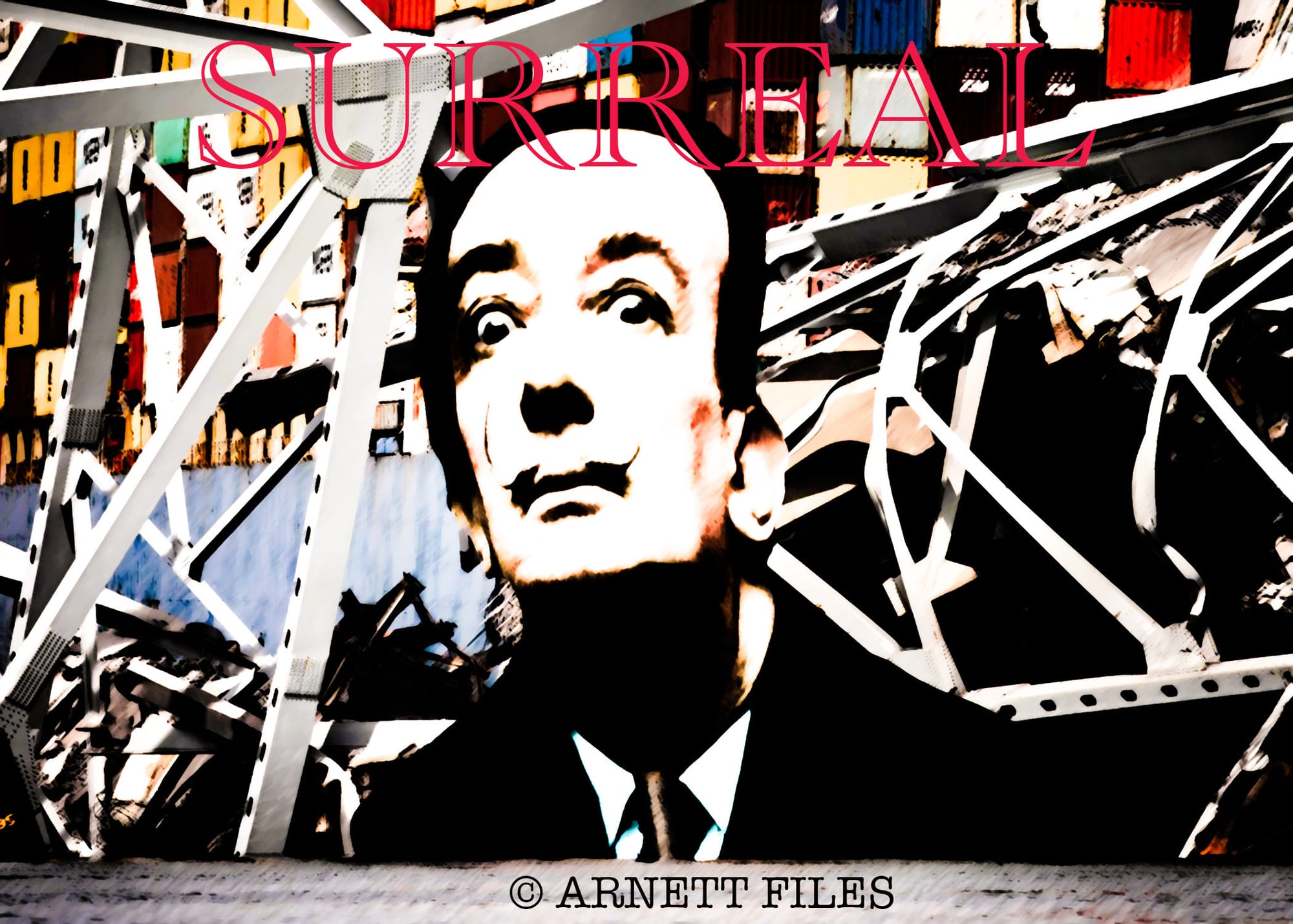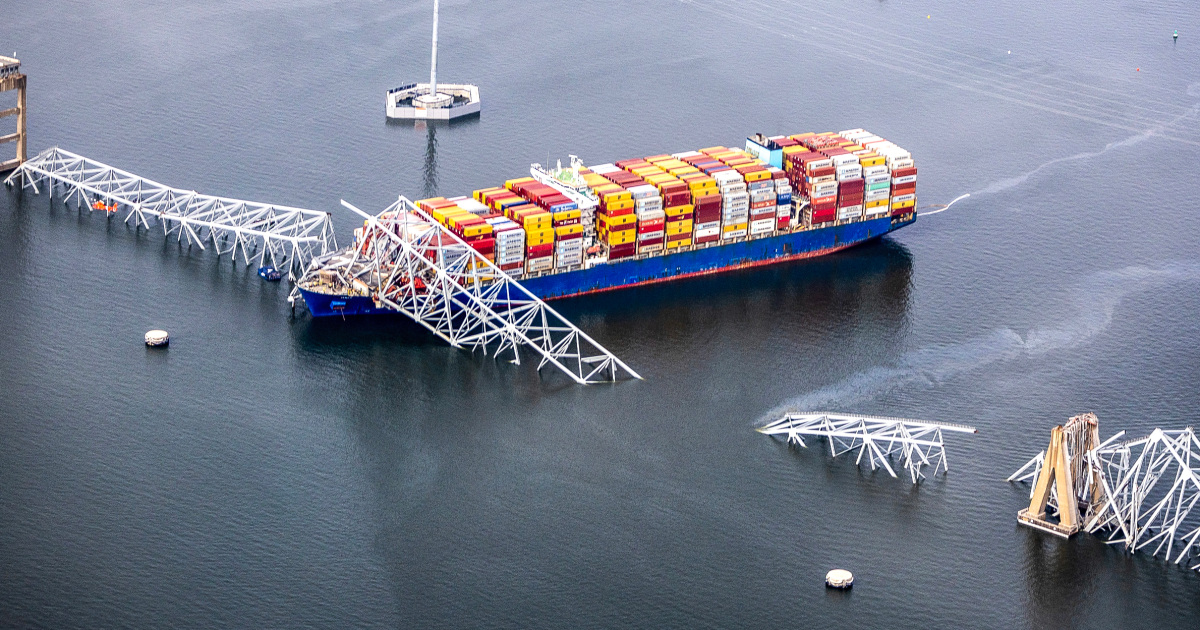Art & Tragedy: Strange Synchronicity In The Baltimore Bridge Collapse

Tragedy. Horrible tragedy. That’s what I woke up to Tuesday morning. The horrific sight of the Francis Scott Key Bridge toppling into the Baltimore Harbor. And of course the ensuing loss of life.
Initial reports warned of a Mass Casualty Situation, as the bridge was part of the Baltimore Beltway and a major thoroughfare. But due to the early hour of the event, only six people have been reported missing and presumed dead.
It was about 1:30 a.m. on Tuesday when the massive cargo ship Dali apparently lost power and careened into one of the pillars holding up the 1.6-mile-long bridge. A Mayday signal sent by the ship alerted officials to stop traffic onto the bridge just moments before its collapse.
It could have been much, much worse. Still, the images of the catastrophe will be forever etched in our minds. I know it will be for me.
Naturally, I was fixated on television and social media coverage, trying to get as much information and make some sense of it all. I confess to obsessively watching CCTV video footage of the crash over and over. I watched it in slow motion. In fast motion. I played it backwards and forwards.
I listened to the press conferences of Baltimore Mayor Brandon M. Scott, Maryland Governor Wes Moore and U.S. Transportation Secretary Pete Buttigieg.
They all acknowledged the gravity of the situation, but details of the circumstance surrounding the event were scant. They insisted, and rightly so, that the main priority was search and rescue for casualties took precedent.
They all agreed on one thing though, and that this event was an accident and not an act of terror. The FBI released a statement, saying: "There is no specific and credible information to suggest any ties to terrorism at this time.”
Still, my fevered brain craved more information. I doom scrolled X through a deluge of collapsed bridge content.
Something weird caught my eye.
The Francis Scott Key Bridge was struck by a ship named Dali
— Vision4theBlind (@Vision4theBlind) March 27, 2024
Spanish artist Salvador Dali had a famous painting back in 1945 called "The Broken Bridge and the Dream" pic.twitter.com/NkdLyA81Fp
The Twitter account @Vision4theBlind posted: “The Francis Scott Key Bridge was struck by a ship named Dali. Spanish artist Salvador Dali had a famous painting back in 1945 called The Broken Bridge of the Dream.”
Attached was an image of the Dali painting showing a broken bridge with a surreal backdrop.
Soon after, I found more accounts posting a similar message. Was it coincidence or did it portend something more?
Salvador Dali was of course the quintessential surrealist artist. Back in the day, when Dali had a falling out with Surrealist leader André Breton and was threatened with excommunication from the group, he brushed it off saying, "The difference between the Surrealists and me is that I am a Surrealist."
When they become available, his paintings sell in the millions of dollars, in the ball park of a Picasso or Miro.
The imagery that Dali conjured in his paintings are ubiquitous and in fact deeply embedded in the psyche of modern man. They sit at that liminal space on the border between consciousness and subconscious. They consist of burning giraffes, lobster telephones, and melting clocks as is found in his most famous painting The Persistence of Memory.
The painting that has instantly become associated with the Baltimore Bridge disaster, called The Broken Bridge of the Dream, was completed in 1945. It is oil on canvas and resides at the Dali Museum in St. Petersburg, Florida. It depicts a decidedly somber tone, with ghost-like figures wandering about and a bridge that has collapsed; a Bridge to Nowhere if you will.
In the official description of the painting, it is noted that Dali places himself sitting beneath the bridge in the Ampurdan plane. Wearing a Catalan red barentina, he drifts off to sleep. In his dreams, the destroyed bridge is transfigured into a stairway that leads up to heaven. This ’stairway to heaven’ is traversed by angelic figures.

Dali had a unique system for painting, in fact he created his own technique for producing art which he termed the paranoiac-critical method. This technique requires the artist to enter into a paranoid state, defined as “fear that the self is being manipulated, targeted or controlled by others.”
In this state, the brain has the ability to perceive links which the rational mind does not see as linked. Dali explained this technique as a "spontaneous method of irrational knowledge based on the critical and systematic objectivity of the associations and interpretations of delirious phenomena.”
This could be rendered in a painting by way of employing a double image or ambiguous image that has multiple layers of meaning. Did Dali use the paranoiac-critical method to foreshadow the coming tragedy in Baltimore?
As well, I would suggest that Dali’s system could be a technique for perceiving phenomena which Carl Jung describes as synchronicity. And there appears to be quite a bit of synchronicity surrounding the Baltimore Bridge collapse.
In other instances of art imitating reality, the good folks on Twitter are calling out some odd coincidences they have found in the recent Netflix film, Leave the World Behind.
The movie shows a dramatic scene where a huge oil tanker runs aground on a beach. After this, a whole string of disasters caused by a cyber attack are unleashed on the country.
As well, the name plastered on the side of the ship in the film is White Lion. Researcher Christopher Knowles points out on his blog that the Dali cargo ship leaving Baltimore was headed towards Columbo, Sri Lanka, whose national flag sports a lion.
SHOCK REPORT:⚠️ More than 1,600 planes are hit by mysterious GPS JAMMING across Europe..
— Chuck Callesto (@ChuckCallesto) March 28, 2024
Since Sunday, aircraft operating over and in the vicinity of the Baltic Sea in northern Europe have experienced technical disruptions due to jamming, with reports from 1614 aircraft,… https://t.co/gWfkrrM9t2 pic.twitter.com/tJfjiclfV2
If this is indeed a case of “predictive programing,” then what comes next?
Later in the movie we see commercial jet airplanes randomly falling from the sky and crashing into the ground.
On Twitter, @ChuckCallesto posted:
“SHOCK REPORT: More than 1,600 planes are hit by mysterious GPS JAMMING across Europe..
Since Sunday, aircraft operating over and in the vicinity of the Baltic Sea in northern Europe have experienced technical disruptions due to jamming, with reports from 1614 aircraft, predominantly civilian, indicating issues since the occurrence began.
Although the majority of these incidents seem to be concentrated in Polish airspace, there are reports from OSINT blogs indicating that aircraft in the airspace of Germany, Denmark, Sweden, Latvia, and Lithuania have also encountered interference issues.”
Let’s hope this is all just a big coincidence.
References:

https://www.wbaltv.com/article/baltimore-bridge-collapse-death-toll-francis-scott-key/60319030




Andrew K. Arnett is a writer and producer. He has been published in Paranoia Magazine, New Dawn, Nexus, Konbini and Alien Buddha Press. He lives in Brooklyn, NY and hunts ghosts with the Brooklyn Paranormal Society. Find him on Twitter: @AndrewArnett


